|
VIII.
|

|
When the French Revolutionists undertook to reconstruct the calendar as they
did everything else, they rearranged the months on the plan
which they called the Republican year. In this new almanac, "Floreal," or the month of flowers, was the eighth in order of succession, and extended from April 20th
to May 19th. This is the month which the painter typifies in his nymph basking in a woodland
glade on a couch of turf and wild-flowers. Louis Joseph Raphael Collin
was born in paris in 1850, and was educated for a profession at the Lyceum Saint Louis and the College of
Verdun. Discarding the original purpose of his career, he, in 1869, entered
the studio of Bouguereau as a pupil, after which he made a course of study under
Cabanel. In 1873 he exhibited his first Salon picture, "Sleep,"
a magnificent nude which
secured him a medal, and is now at the Museum of Rouen. In 1875 another
picture of similar character was bought out of the Salon by the Government for
the Arras Museum, and in 1877 his "Daphne and Chloe" was also purchased for the Museum
of Alencon. He has been a member of the Legion of Honor since 1884.
|

|
In the hands of Albert Aublet,
"The New Moon" becomes a graceful female figure, which forms a
crescent in a sky fleeced with clouds, that
wreath in vapors above the pale peaks of the legendary Mountains of the Moon.
|

|
"The Gypsy" of
Fritz Zuber-Buhler is one of those itinerant dancing-girls common in portions of
Southern Europe still, who reclines by the roadside in the forest to doze and dream
away the summer noonday.
|

|
Jules Lefebvre represents in "Salome," the daughter of Herodias, an essentially Semitic type of the antique period,
with the sensuous and souless beauty of the tigress rather than the woman,
bearing the charger which is to receive the head of John the Baptist, and the sword which is to
decapitate him, as indifferently as if it were a dish of fruit.
|

|
Mme. Adelheid Salles-Wagner, born in 1825 in Dresden,
is the elder of two sisters, both of whom are well-known painters. Her family name is Wagner.
Her sister Elise, who became Madame Puyroche, devoted herself to flower painting.
Adelheid studied the figure, first at the Dresden Academy and later under
Jacquand and Cogniet in Paris. There she met and married the well-known artist
Jules Salles, a native of Nimes and pupil of Paul Delaroche. Mme. Salles-Wagner made
her first successes with portraits, in oil and in pastel, and then produced a series of
mythological and religious pictures of rare merit. In her present picture,
the chaste Arethusa, persecuted by the persistent attentions of the love
smitten Arcadian river-god Alpheius, prays to Diana for protection against his unwelcome
importunities, and is being changed by her into
the magic fountain of Artygia.
|

|
One of the most distinguished artistic figures of our time is that of Charles Auguste Emile Duran,
or, as he has chosen to Latinize and abbreviate his name, Carolus Duran. He was born at Lille in 1837, and first
studied there under the direction of the old painter Souchon. Souchon was famous as a copyist
of the old masters, and he impressed their study on his pupil as more valuable than the direct
instruction of any living artist. The youth made rapid progress under his advice,
and in 1853 went to Paris, where he appears to have subsisted by the
sale of his copies, doing little other painting, but associating much with other art
students, among whom is wit, fluency of conservation, and energetic character rendered him a leader. In 1861 his native city appropriated a pension for him,
upon which he might study in Italy. In 1866, he went to Spain, where he made
a close study of the Spanish masters, particularly Velasquez, and upon his return
to France took up the painting of the nude with triumphant success, and
portraiture, in which he soon proved himself a master, especially when he had women or
children for subjects. Religious subjects and decorative work came equally easy
to his hand. His "Red-Haired Lelia" is a portrait of a well-known Paris
model, and painted in such a way that it may be truly said to live. Duran is a writer as well as a painter, and has published several books. His medals may almost be
said to be numberless, and they are headed by the coveted Medal of Honor, which
was awarded to him in 1879. He has been an Officer of the Legion of Honor since 1878.
His wife, Mme. Pauline Marie Carolus Duran, who was born at St. Petersburg, is also a painter of merit.
|
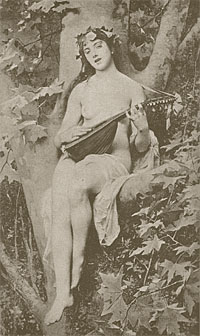
|
Another of the great modern exponents of figure painting in France, though
in a totally different feeling and manner to Carolus Duran, is
Leon Basile Perrault, who was born at Poitiers in 1832.
He was a student under Picot and Bouguereau, and obtained an Honorable Mention for his
very first exhibit at the Salon, in 1861. He took his first medal three years later, and
many of his works have been acquired by the State for various museums. His pictures are
well known in the United States, where they have long been popular with collectors.
In addition to exact
paintings he has executed a number of important decorations, and as a portrait painter
his place is inthe first rank. Perrault is a strong and careful draughtsman, a fine colorist,
and a finished but not labored executant. His composition is always happy, his subjects well chosen, pleasing and full of interest, and his pictures have that quality which causes people to say: "His figures
live and speak." His
"La Cigale" was in the Salon of 1893. In it he gives a charming
interpretation of the fable. The merry grasshopper sings her song, careless of the approach of winter which is prognosticated by the autumn foliage in which she is
embowered. It is
an idyll of the thoughtless gayety of light-hearted life, heedless of anything
beyond the day, and revelling in the full enjoyments of the present.
|
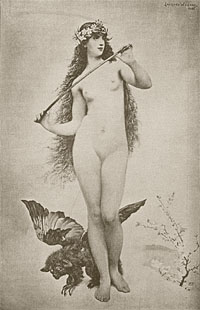
|
Jacques Clement Wagrez was born in Paris in 1850.
His father was a painter of some ability and from him he received his first instruction. At different
periods afterward he studied, at the Ecole des Beaux Arts, under Farochon,
Lenepveu, Pils, and Henri Lehmann, the two latter of whom most influenced him. Appearing
first at the Salon in 1876 with a portrait and mythological subject, "Eros," which created remark, and in 1878 his "Education of Achilles by the Centaur" won him a
medal and was purchased by the Government for the Aurillac Museum. He early
began to give much attention to painting for purposes of decoration, and produced many water-colors and designs for the illustration of costly
artistic publications. His "Spring Fairy" is one of a series of
panels intended for the decoration of a private mansion, and the idea is derived from an old
French tale, of the descent from her home among the clouds of the deity who brings the warm mists,
the sunlight, and the flowers of spring, to the earth. The nondescript beast which
accompanies her seems to have been introduced by the artist in a purely whimsical and fantastic
spirit, as it has no place in the legend upon which the picture is based.
|
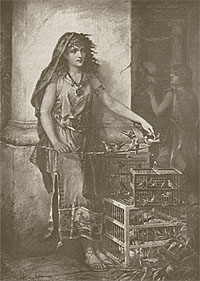
|
In Pompeii the catching and training of wild birds for sale was quite
an important employment of the poorer classes, among whom the professional
bird-snarers formed an independent body. Miss Coomans shows
a Pompeiian girl, inviting attention to her wares in the market-place.
|

|
The "Mother and Child" of Charles Landelle
is a souvenir of the artist's tour of Algeria, of which Tlemcen is the chief
town of the Department of Oran, the most western of the three administrative divisions of the colony.
The admixture of the French with the Arab population has produced some curious modifications
of the native costume, a hint of which may be found in the dress both of the woman and the
sleeping girl.
|

|
Jules Louis Machard was born at Sampans, in the Jura, in 1839, was a pupil of Picot and Signal,
and in 1865 captured the Prix de Rome. He is a painter of portraits, history,
classical, and fanciful subjects, of which latter his "Soap Bubbles"
is an excellent example. He has been a Member of the Legion of Honor since 1878.
|

|
Unquestionably the most famous of the late Alexandre Cabanel's
pictures is his "Birth of Venus." The original painting is in the collection of the Luxembourg, but engravings,
photographs, and other reproductions have made it familiar to the world world as one of the foremost
classics of modern art. Under a sky rosy with dawn, Venus Astarte wakes to life on the waves
of which she is born. The picture is not only of a matchelss grace of composition, but in its soft,
delicate color and tender modeling the crowning masterpiece of the artist's productions.
It was first exhibited at the Salon of 1875, where it made the sensation of the year.
|
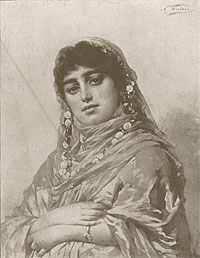
|
In "An Odalisque" N. Sichel again
reveals the felicity and variety of his talent in creating beautiful female types. The face is thoroughly
characteristic and the attitude and drapery graceful and picturesque.
|

|
Konrad Delitz, the painter of "The Spirit of the Alps," has taken a Tyrolean legend for his subject.
This popular tale belongs to the Bavarian Alps, in which most of the artist's mountain studies were made.
A chamois hunter has been led by the ardor of the chase to the very snow line of the loftiest peak of the range. Here the
last scanty vegetation that clothes the mountain-side ceases. Wearied by his exeretions, the hunter
lies down to sleep upon the narrow and dangerous ledge, and the fairy of the
mountains discovers the intruder on her domain. His young and beauty charm
away any resentment which she might entertain against his trespass, and she
plucks an edelweiss, the mountain flower which grows in the highest and most inaccessible places,
to place it in his hand as a protecting talisman.
|

|
Miss Diana Coomans turns from Pompeii to Athens for
"At the Callirhoe Spring." The fountain of Callirhoe, called the fountain of nine springs, because
its waters were distributed in that number of channels, was credited with magical properties and powers, and its fluid treasure was sought with prayer and floral invocation by the maidens,
to whom it was supposed to bring good fortune in
affairs of the heart. The fountain, it may be added, derived its name from the
daughter of the river-god Achelus, to whom it was dedicated.
|

|
The "Daphne"
of Emmanuel Benner also dives into Greek legend for its subject.
Daphne, a beautiful nymph of the forest and stream, became the object of a violent passion on
the part of Apollo. She scorned him. He pursued her, and she called upon her mother, the Earth, for succor. The
appeal was answered. According to one version of the fable she was turned into a laurel tree just as Apollo was about to grasp her, and
the laurel was thenceforward a tree sacred to all poets and heroes, and was used as a crown of honor. The name of the transformed nymph was
given to the grove in which her transformation occurred, and in which was erected a sanctuary
and temple to Apollo and Diana.
|
|
|
|





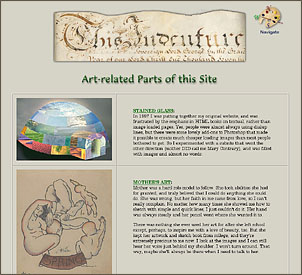



![]() Copyright © 2007, Mary S. Van Deusen
Copyright © 2007, Mary S. Van Deusen